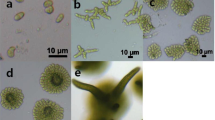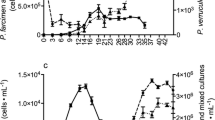Abstract
Survival and growth of early post-settlement stages are critical for the development of seaweed populations. Fucoid germlings commonly settle in dense monospecific aggregates, where intraspecific competition and environmental variables (e.g. nutrient concentration and temperature) may affect survival and growth. Using factorial experiments, we determined the effects of settlement density (~10, ~50 and ~250 germlings cm−2), nutrient enrichment (from ~10 to ~40 µM N and from ~0.5 to ~2.5 µM P), and temperature (7°C and 17°C) on Fucus serratus and F. evanescens germlings in laboratory cultures over 3 months. Settlement density, nutrient concentration and temperature interactively affected growth of germlings, and the magnitude of this interaction varied between the two species. This represents the first record of such factorial interactions in Fucus spp. germlings. Intraspecific competition, estimated as the relative reduction in germling growth and survival from low to high densities, increased with decreasing nutrient concentration and increasing temperature in both species. While temperature and nutrient concentration had little effect on germling size distributions, size inequality and skewness generally increased with germling density, indicating that a few large individuals gained dominance and suppressed many smaller ones at high density. Self-thinning increased with settlement density and depended on nutrient concentration and species at high density. At high density, self-thinning increased with decreasing nutrient levels in F. evanescens, but not in F. serratus. At low density, nutrient enrichment increased germling growth in F. evanescens, but not in F. serratus, whereas growth in both species was stimulated by nutrient enrichment at higher densities. These results suggest that germling growth and self-thinning are more sensitive to variation in nutrient concentration in F. evanescens than in F. serratus. The potential implications of our findings for the understanding of eutrophication-related abundance changes in both species in southern Norway are discussed.




Similar content being viewed by others
References
Andrew NL, Viejo RM (1998) Effects of wave exposure and intraspecific density on the growth and survivorship of Sargassum muticum (Sargassaceae: Phaeophyta). Eur J Phycol 33:251–258
Ang POJ, DeWreede RE (1992) Density-dependence in a population of Fucus distichus. Mar Ecol Prog Ser 90:169–181
Arenas F, Fernández C (2000) Size structure and dynamics in a population of Sargassum muticum (Phaeophyceae). J Phycol 36:1012–1020
Arenas F, Viejo RM, Fernández C (2002) Density-dependent regulation in an invasive seaweed: responses at plant and modular levels. J Ecol 90:820–829
Arrontes J (2002) Mechanisms of range expansion in the intertidal brown alga Fucus serratus in northern Spain. Mar Biol 141:1059–1067
Bertness MD, Leonard GH, Levine JM, Schmidt PR, Ingraham AO (1999) Testing the relative contribution of positive and negative interactions in rocky intertidal communities. Ecology 80:2711–2726
Bi H, Turvey ND (1997) A method of selecting data points for fitting the maximum biomass–density line for stands undergoing self-thinning. Aust J Ecol 22:356–359
Bokn T, Lein TE (1978) Long-term changes in fucoid association of the inner Oslofjord, Norway. Norw J Bot 25:9–14
Bokn TL, Murray S, Moy FE, Magnusson JB (1992) Changes in fucoid distribution and abundance in the inner Oslofjord, Norway: 1974–80 versus 1988–90. Acta Phytogeogr Suec 78:117–124
Brawley SH, Johnson LE (1991) Survival of fucoid embryos in the intertidal zone depends upon developmental stage and microhabitat. J Phycol 27:179–186
Carmer SG, Walker UM (1982) Baby Bear's dilemma: a statistical tale. Agron J 74:122–124
Choi HG (2001) The effects of density on algal competition in culture and the field. PhD thesis, University of Liverpool, Liverpool
Creed JC (1995) Spatial dynamics of a Himanthalia elongata (Fucales, Phaeophyta) population. J Phycol 31:851–859
Creed JC, Norton TA, Harding SP (1996a) The development of size structure in a young Fucus serratus population. Eur J Phycol 31:203–209
Creed JC, Norton TA, Kain JM (1996b) Are neighbours harmful or helpful in Fucus vesiculosis populations? Mar Ecol Prog Ser 133:191–201
Creed JC, Norton TA, Kain JM (1997) Intraspecific competition in Fucus serratus germlings: the interaction of light, nutrients and density. J Exp Mar Biol Ecol 212:211–223
Creed JC, Kain JM, Norton TA (1998) An experimental evaluation of density and plant size in two large brown seaweeds. J Phycol 34:39–52
Crowley PH (1992) Resampling methods for computation-intensive data analysis in ecology and evolution. Annu Rev Ecol Syst 23:405–447
Dean TA, Thies K, Lagos SL (1989) Survival of juvenile giant kelp: the effects of demographic factors, competitors, and grazers. Ecology 70:483–495
Dixon PM (2001) The bootstrap and the jackknife: describing the precision of ecological indices. In: Scheiner SM, Gurevitch J (eds) Design and analysis of ecological experiments. Oxford University Press, New York, pp 267–288
Grace JB (1995) On the measurement of plant competition intensity. Ecology 76:305–308
Grenager B (1957) Algological observations from the polluted area of the Oslofjord. Nytt Mag Bot (Oslo) 5:41–60
Grime JP (1977) Evidence for the existence of three primary strategies in plants and its relevance to ecological and evolutionary theory. Am Nat 111:1169–1194
Howell DC (1992) Statistical methods for psychology. Duxbury, Belmont
Hruby T, Norton TA (1979) Algal colonization on rocky shores in the Firth of Clyde. J Ecol 67:65–77
Hurlbert SH (1990) Pastor binocularis: now we have no excuse. Ecology 71:1222–1223
Karez R (2003) Do monospecific stands of three Fucus species (Phaeophyta) comply with the 'self-thinning rule'? Eur J Phycol 38:171–180
Kendrick GA (1994) Effects of propagule settlement density and adult canopy on survival of recruits of Sargassum spp. (Sargassaceae: Phaeophyta). Mar Ecol Prog Ser 103:129–140
Kokko H, Mackenzie A, Reynolds JD, Lindstrom J, Sutherland WJ (1999) Measures of inequality are not equal. Am Nat 154:358–382
Kristiansen S, Paasche E (1982) Nitrogen nutrition of the phytoplankton in the Oslofjord. Estuar Coast Shelf Sci 14:237–249
Lonsdale WM (1990) The self-thinning rule: dead or alive? Ecology 71:1373–1388
Lotze HK, Worm B, Sommer U (2001) Strong bottom-up and top-down control of early life stages of macroalgae. Limnol Oceanogr 46:749–757
Markham JH, Chanway CP (1996) Measuring plant neighbour effects. Funct Ecol 10:548–549
Markham JW, Hagmeier E (1982) Observations on the effects of germanium dioxide on the growth of macroalgae and diatoms. Phycologia 21:125–130
Mead R (1991) The design of experiments. Statistical principles for practical applications. Cambridge University Press, Cambridge
Morris CE (1999) Density-dependent mortality induced by low nutrient status of the substrate. Ann Bot (Lond) 84:95–107
Morris CE (2002) Self-thinning lines differ with fertility level. Ecol Res 17:17–28
Morris CE (2003) How does fertility of the substrate affect intraspecific competition? Evidence and synthesis from self-thinning. Ecol Res 18:287–305
Morris CE, Myerscough PJ (1985) Nutrient level effects on thinning and non-thinning crowding effects in even aged population of subterranean clover. Aust J Ecol 10:469–479
Osawa A, Sugita S (1989) The self-thinning rule: another intepretation of Weller's results. Ecology 70:279–283
Paine RT (1990) Benthic macroalgal competition: complications and consequences. J Phycol 26:12–17
Quatrano RS (1980) Gamete release, fertilization, and embryogenesis in the Fucales. In: Gantt E (ed) Handbook of phycological methods. Developmental and cytological methods. Cambridge University Press, Cambridge, pp 59–68
Reed DC (1990) An experimental evaluation of density dependence in a subtidal algal population. Ecology 71:2286–2296
Rueness J (1998) Alger i farger. Almater, Oslo
Schmitt HJ, Eccleston J, Ehrhardt DW (1987) Dominance and suppression, size-dependent growth and self-thinning in a natural Impatiens capensis population. J Ecol 75:651–665
Schmitt J, Ehrhardt EW, Cheo M (1986) Light-dependent dominance and suppression in experimental radish populations. Ecology 67:1502–1507
Silvertown JW, Charlesworth D (2001) Introduction to plant population biology. Blackwell, Oxford
Sokal RR, Rohlf FJ (1995) Biometry: the principles and practice of statistics in biological research. Freeman, New York
Soto D, Hurlbert SH (1991) Long-term experiments on calanoid–cyclopoid interactions. Ecol Monogr 61:245–265
Steen H (2003) Intraspecific competition in Sargassum muticum (Phaeophyceae) germlings under various density, nutrient and temperature regimes. Bot Mar 46:36–43
Steen H, Rueness J (2004) Comparison of survival and growth in germlings of six fucoid species (Fucales, Phaeophyceae) at two different temperature and nutrient levels. Sarsia (in press)
Turner MD, Rabinowitz D (1983) Factors affecting frequency distributions of plant mass: the absence of dominance and suppression in competing monocultures of Festuca paradoxa. Ecology 64:469–475
Vadas RL Sr, Johnson S, Norton TA (1992) Recruitment and mortality of early post-settlement stages of benthic algae. Br Phycol J 27:331–351
Weiner J (1985) Size hierarchies in experimental population of annual plants. Ecology 66:743–752
Weiner J, Thomas SC (1986) Size variability and competition in plant monocultures. Oikos 47:211–222
Weller DE (1987) A reevaluation of the −3/2 power rule of plant self-thinning. Ecol Monogr 57:23–43
Weller DE (1989) The interspecific size–density relationship among crowded plant stands and its implications for the −3/2 power rule of self-thinning. Am Nat 133:20–41
Westoby M (1984) The self-thinning rule. Adv Ecol Res 14:167–225
Worm B, Lotze HK, Sommer U (2001) Algal propagule banks modify competition, consumer and resource control on Baltic rocky shores. Oecologia 128:281–293
Yoda K, Kira T, Ogawa H, Hozumi K (1963) Self-thinning in overcrowded pure stands under cultivated and natural conditions. Intraspecific competition among higher plants. XI. J Biol Osaka City Univ 14:107–129
Acknowledgements
We thank the staff at the Norwegian Institute for Water Research (NIVA), Marine Research Station at Solbergstrand, for supplying seawater and nutrients. Thanks to Prof. J. Rueness, Dr. S. Fredriksen, Dr. T. Andersen, and Dr. L. J. Naustvoll, for sharing their knowledge and making helpful comments on earlier versions of the manuscript. Finally, we thank Dr. S. Blank, for providing valuable technical assistance with the resampling software, and two anonymous referees, for reviewing and improving the quality of this paper. This study complied with environmental laws of Norway.
Author information
Authors and Affiliations
Corresponding author
Additional information
Communicated by L. Hagerman, Helsingør
Rights and permissions
About this article
Cite this article
Steen, H., Scrosati, R. Intraspecific competition in Fucus serratus and F. evanescens (Phaeophyceae: Fucales) germlings: effects of settlement density, nutrient concentration, and temperature. Marine Biology 144, 61–70 (2004). https://doi.org/10.1007/s00227-003-1175-8
Received:
Accepted:
Published:
Issue Date:
DOI: https://doi.org/10.1007/s00227-003-1175-8




